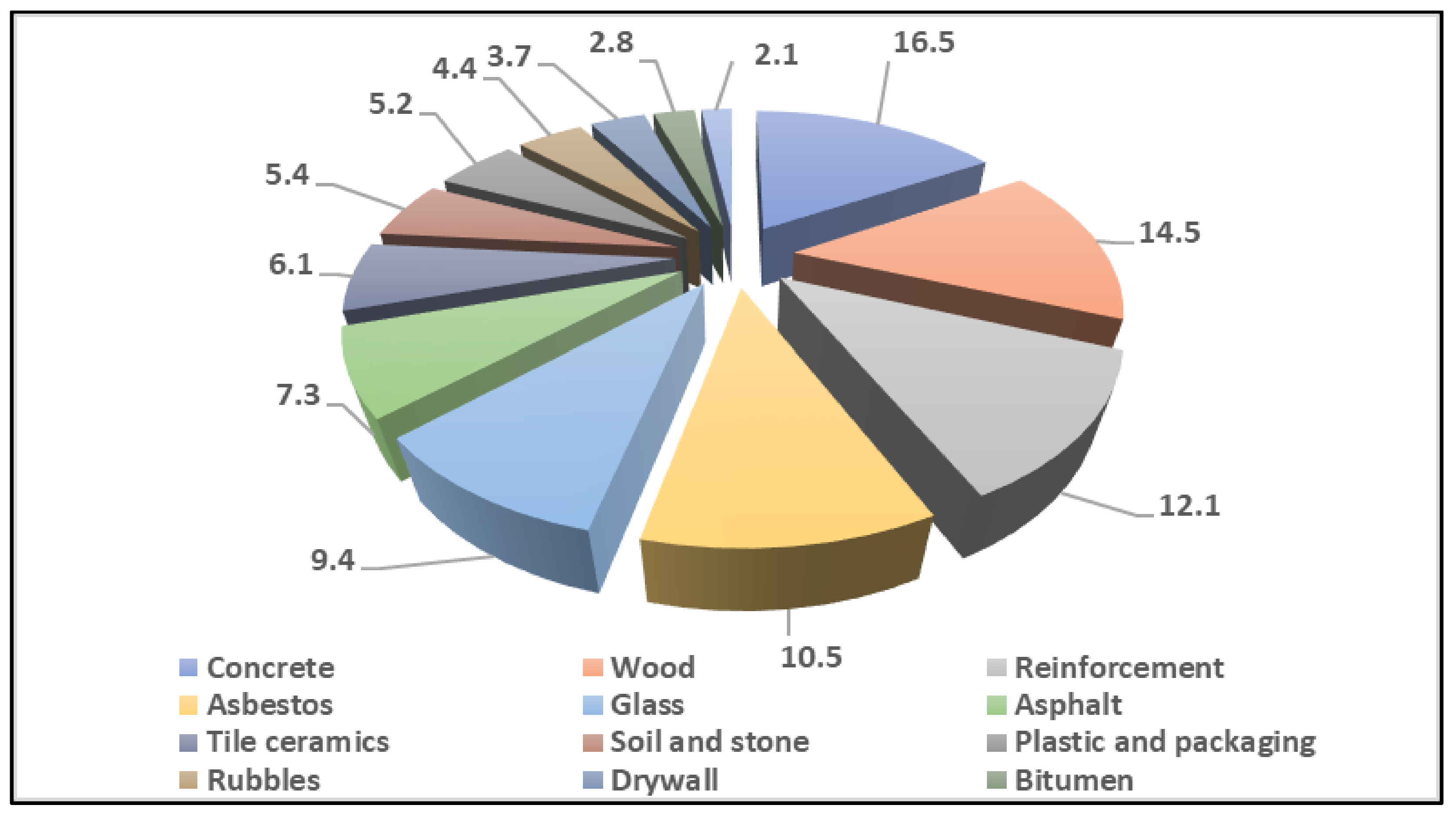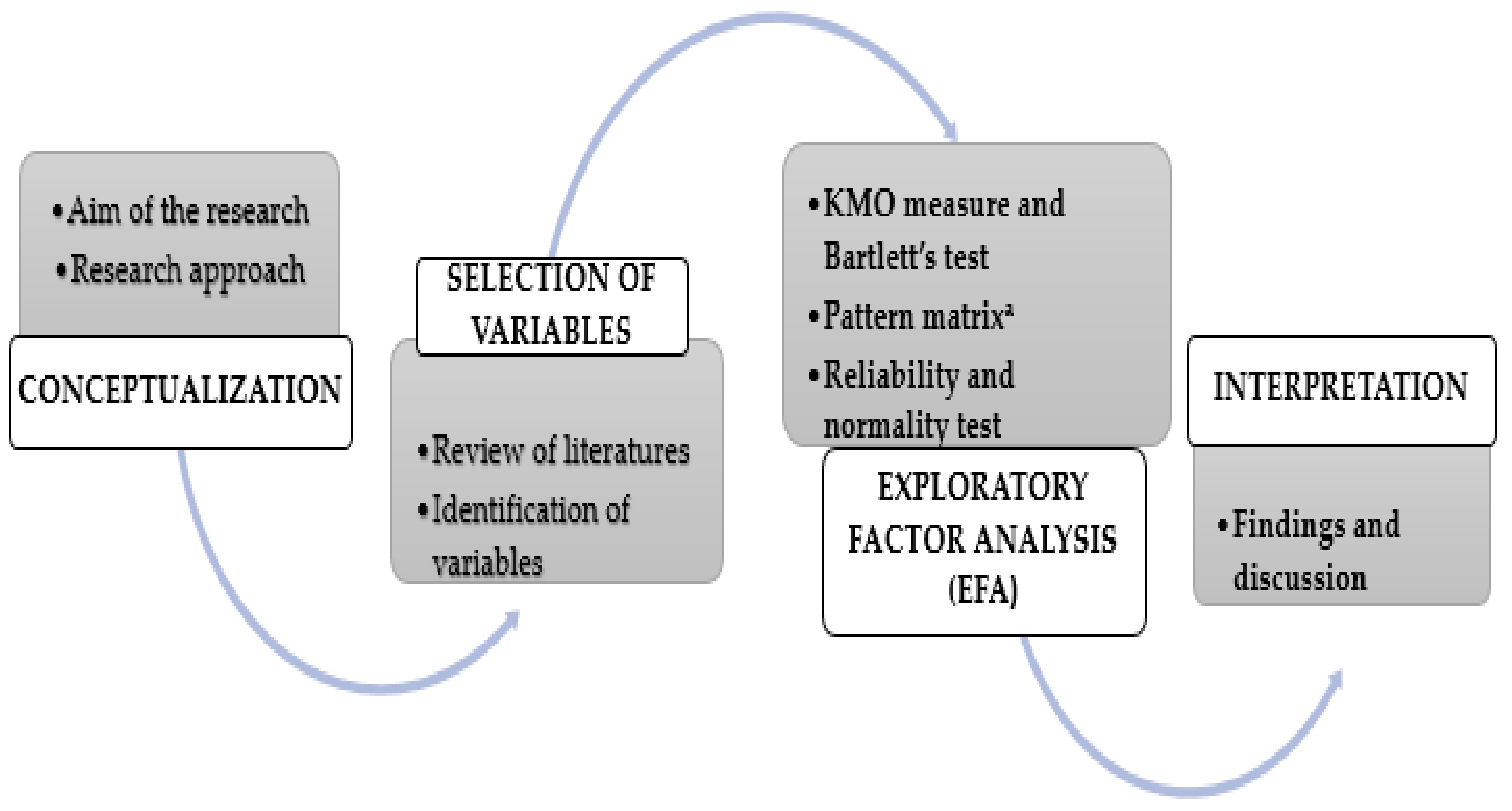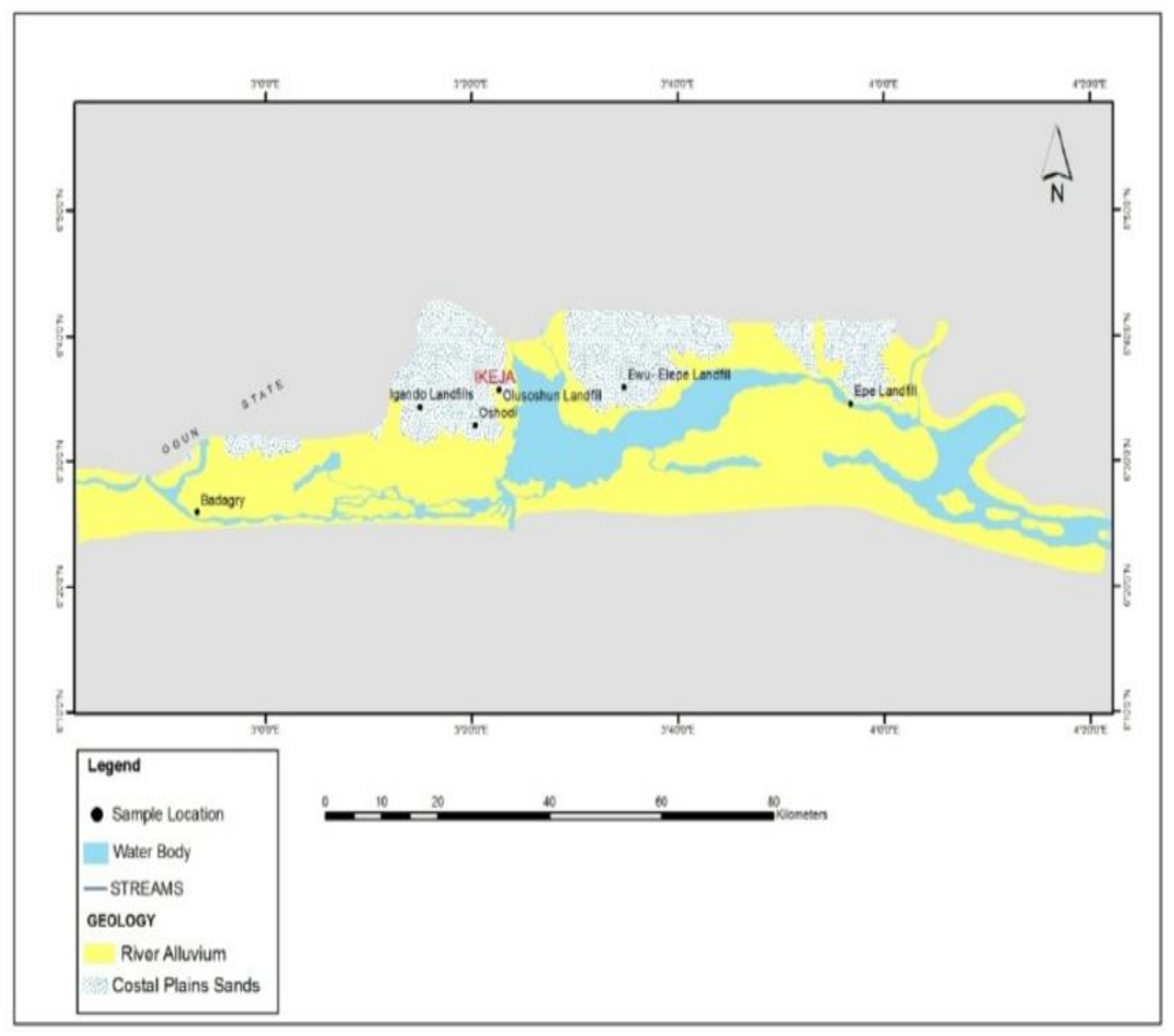A Holistic Assessment of Construction and Demolition Waste Management in the Nigerian Construction Projects
Abstract
1. Introduction
2. Materials and Methods
2.1. Study Area
2.2. Survey Instrument
2.3. Data Analysis
3. Results
3.1. Demographic Information
3.2. Mean Item Score
3.3. Exploratory Factor Analysis (EFA)
3.3.1. Measure of Sampling Adequacy
3.3.2. Pattern Matrix
3.3.3. Reliability and Normality Test
4. Discussion
4.1. Cluster Description
4.1.1. Cluster 1—Legal Framework and Modular Construction
4.1.2. Cluster 2—Sustainable Procurement and Material Optimisation
4.1.3. Cluster 3—Construction Detailing and Design
4.1.4. Implication of Findings
5. Conclusions
6. Recommendation
Supplementary Materials
Author Contributions
Funding
Informed Consent Statement
Data Availability Statement
Acknowledgments
Conflicts of Interest
Abbreviations
| BIM | Building information modelling |
| C&DW | Construction and demolition waste |
| EFA | Exploratory factor analysis |
| LASWMA | Lagos State waste management agency |
| WRAP | Waste and Resources Action Programme |
| EU | European Union |
| EEA | European Environmental Agency |
References
- Nagapan, I.S.; Abul-Rahman, I.A.; Aziz, A.A. Construction waste management: Malaysian perspective. In Proceedings of the International Conference on Civil and Environmental Engineering Sustainability, Johor Bahru, Malaysia, 3–5 April 2012; pp. 299–309. [Google Scholar]
- Shen, L.Y.; Tam, V.W.; Tam, C.M.; Drew, D. Mapping approach for examining waste management on construction sites. J. Constr. Eng. Manag. 2004, 130, 472–481. [Google Scholar] [CrossRef]
- Aboginije, A.J. Assessment of Construction and Demolition Waste Management System in the Nigerian Construction Industry. Master’s Dissertation, University of Johannesburg, Johannesburg, South Africa, 2020. [Google Scholar]
- Abioye, A.; Rao, B. Sustainable approach to managing construction and demolition waste: An opportunity or a new challenge. J. Innov. Res. Sci. Eng. Technol. 2015, 4, 10368–10377. [Google Scholar] [CrossRef]
- Aboginije, A.J.; Aigbavboa, C.O.; Thwala, W.; Samuel, S. Determining the impact of construction and demolition waste reduction practices on green building projects in Gauteng province, South Africa. In Proceedings of the International Conference of Industrial Engineering and Operation Management, Dubai, UAE, 10–12 March 2020; pp. 1027–1038. [Google Scholar]
- Thomas, H.C. Solid Waste Technology and Management 1&2, 1st ed.; Blackwell Publishing Ltd.: Hoboken, NJ, USA, 2010; pp. 61–84. [Google Scholar]
- Begum, R.A.; Satari, S.K.; Pereira, J.J. Waste generation and recycling: Comparison of conventional and industrialized building systems. Am. J. Environ. Sci. 2010, 6, 383–388. [Google Scholar] [CrossRef]
- Ekanayake, L.L.; Ofori, G. Construction material waste source evaluation. In Proceedings of the 2nd Southern Africa Conference on Sustainable Development in the Built Environment, Pretoria, South Africa, 23–25 August 2000; pp. 1–6. [Google Scholar]
- Huang, J.; Zhao, R.; Huang, T.; Wang, X.; Tseng, M.L. Sustainable municipal solid waste disposal in the belt and road initiative: A preliminary proposal for Chengdu city. Sustainability 2018, 10, 1147. [Google Scholar] [CrossRef]
- Vergara, S.E.; Tchobanoglous, G. Municipal solid waste and the environment: A global perspective. Environ. Resour. 2012, 37, 277–309. [Google Scholar] [CrossRef]
- Elgizawy, S.M.; El-Haggar, S.M.; Nassar, K. Approaching sustainability of construction and demolition waste using zero waste concept. Low Carbon Econ. 2016, 7, 1–16. [Google Scholar] [CrossRef]
- Zhao, W.; Ren, H.; Rotter, V. A system dynamics model for evaluating the alternative of type in construction and demolition waste recycling center—the case of Chongqing, China. J. Resour. Conserv. Recycl. 2011, 55, 933–944. [Google Scholar] [CrossRef]
- Hwang, B.G.; Yeo, Z.B. Perception on benefits of construction waste management in the Singapore construction industry. Eng. Constr. Archit. Manag. 2011, 18, 394–406. [Google Scholar] [CrossRef]
- Tam, V.W.; Shen, L.Y.; Fung, I.W.; Wang, J.Y. Controlling construction waste by implementing governmental ordinances in Hong Kong. J. Constr. Innov. 2007, 7, 149–166. [Google Scholar] [CrossRef]
- Ghiani, G.; Laganà, D.; Manni, E.; Musmanno, R.; Vigo, D. Operations research in solid waste management: A survey of strategic and tactical issues. Comput. Oper. Res. 2014, 44, 22–32. [Google Scholar] [CrossRef]
- Xiao, S.; Dong, H.; Geng, Y.; Brander, M. An overview of China’s recyclable waste recycling and recommendations for integrated solutions. Resour. Conserv. Recycl. 2018, 134, 112–120. [Google Scholar] [CrossRef]
- Tongo, S.O.; Oluwatayo, A.A.; Adeboye, B.A. Factors influencing waste generation in buildings project in South-west, Nigeria. Int. J. Waste Resour. 2019, 10, 1–4. [Google Scholar] [CrossRef]
- Wahab, A.B.; Lawal, A.F. An evaluation of waste control measures in construction industry in Nigeria. Afr. J. Environ. Sci. Technol. 2011, 5, 246–254. [Google Scholar] [CrossRef]
- Wang, R.; Li, S. Talking about the production and disposing of construction waste from the view of sustainable development. In Proceedings of the Power and Energy Engineering Conference (APPEEC), Wuhan, China, 25–28 March 2011; pp. 1–4. [Google Scholar] [CrossRef]
- Yuan, H. Critical management measures contributing to construction waste management: Evidence from construction projects in china. Proj. Manag. J. 2014, 44, 101–112. [Google Scholar] [CrossRef]
- Yuan, H. Barriers and countermeasures for managing construction and demolition waste: A case of Shenzhen in China. J. Clean. Prod. 2017, 157, 84–93. [Google Scholar] [CrossRef]
- Zhang, N.; Zheng, L.; Duan, H.; Yin, F.; Li, J.; Niu, Y. Differences of methods to quantify construction and demolition waste for less-developed but fast-growing countries: China as a case study. Environ. Sci. Pollut. Res. 2019, 26, 25513–25525. [Google Scholar] [CrossRef]
- Waste Resources Action Plan (WRAP). Achieving Good Practice Waste Minimization and Management: Guidance for Construction Clients, Design Teams and Contractors. 2007. Available online: www.wrap.org.uk/construction (accessed on 29 November 2020).
- Poon, C.S.; Yu, A.T.; Jaillon, L. Reducing building waste at construction sites in Hong Kong. J. Constr. Manag. Econ. 2004, 22, 461–470. [Google Scholar] [CrossRef]
- Kofoworola, O.F.; Gheewala, S.H. Estimation of construction waste generation and management in Thailand. Waste Manag. 2009, 29, 731–738. [Google Scholar] [CrossRef]
- European Environmental Agency (EEA). Municipal Waste Management across European Countries. 2019. Available online: https://www.eea.europa.eu/publications/emep-eea-guidebook (accessed on 12 December 2020).
- Garba, A.; Olaleye, Y.O.; Jibrin, N.S. Material resources optimization for sustainable construction in Nigeria. J. Eng. Archit. 2016, 4, 33–47. [Google Scholar] [CrossRef]
- Garas, G.L.; Anis, A.R.; Gammal, A.E. Materials waste in the Egyptian construction industry. In Proceedings of the IGLC-9, Rent Ridge Crescent, Singapore, 6–11 August 2001. [Google Scholar]
- Adafin, J.K.; Daramola, O.; Ayodele, E.O. A study of material control strategies in some selected construction firms in Nigeria. Cont. J. Appl. Sci. 2010, 1, 62–72. [Google Scholar]
- Adebayo, W.O.; Bamisaye, J.A.; Akintan, O.B.; Ogunleye, O.S. Waste generation, disposal management technique in an urbanizing environment: A case study of Ado-Ekiti, Nigeria. Res. J. Appl. Sci. 2012, 1, 66. [Google Scholar]
- Aderibigbe, Y.W.; Ataguba, O.C.; Sheyin, Y. Minimization of wastage of material on construction sites in Nigeria. Int. J. Adv. Acad. Res. 2017, 3, 1–15. [Google Scholar] [CrossRef]
- Adewuyi, T.O.; Odesola, I.A. Material waste minimisation strategies among construction firms in South-South, Nigeria. Int. J. Sustain. Constr. Eng. Technol. 2016, 7, 11–29. [Google Scholar]
- Adewuyi, T.O.; Idoro, G.I.; Ikpo, I.J. Empirical Evaluation of Construction Material Waste Generated on Sites in Nigeria. J. Civ. Eng. Sci. Appl. 2014, 16, 96–103. [Google Scholar] [CrossRef][Green Version]
- Agamuthu, P.; Hamid, F.S.; Khidzir, K. Evolution of solid waste management in Malaysia: Impacts and Implications of the Solid Waste Bill 2007. J. Mater. Cycles Waste Manag. 2009, 11, 96–103. [Google Scholar] [CrossRef]
- Ajayi, S.O.; Oyedele, L.O.; Akinade, O.O.; Bilal, M.; Alaka, H.A.; Owolabi, H.A. Optimising material procurement for construction waste minimization: An exploration of success factors. Sustain. Mater. Technol. 2017, 11, 38–46. [Google Scholar] [CrossRef]
- Popoola, O.; Adeleke, J.; Ayegbokiki, S. An investigation into material wastage on building construction sites (case study of selected building construction sites in Osun state). Int. J. Sci. Eng. Environ. Technol. 2018, 3, 18–26. [Google Scholar]
- Akanni, P.O. An empirical survey of the effect of materials wastage on contractors’ profit level in construction projects. prof. build. J. Niger. Inst. Build. 2007, 35–46. [Google Scholar] [CrossRef][Green Version]
- Akinkurolere, O.O.; Franklin, S.O. Investigation into waste management on construction sites in South Western Nigeria. Am. J. Appl. Sci. 2005, 2, 980–984. [Google Scholar] [CrossRef]
- Akinade, O.O.; Oyedele, L.O.; Ajayi, S.O.; Bilal, M.; Alaka, H.A.; Owolabi, H.A.; Bello, S.A.; Jaiyeoba, B.E.; Kadiri, K.O. Design for Deconstruction (DfD): Critical success factors for diverting end-of-life waste from landfills. J. Waste Manag. 2017, 60, 3–13. [Google Scholar] [CrossRef]
- Aniramu, O.; Adetoro, O.; Salami, A. An integrated assessment of waste materials generation and waste minimization strategy appraisal in Ikogosi township, Nigeria. Int. J. Res. Sci. Innov. 2019, VI, 20–24. [Google Scholar]
- Ajayi, O.M.; Koleoso, H.A.; Soyingbe, A.A.; Oladiran, O.J. The practice of waste management in construction sites in Lagos state; Nigeria. In Proceedings of the Construction and Building Research Conference of the Royal Institution of Chartered Surveyors, Kaduna, Nigeria, 4 September 2008. [Google Scholar]
- Akujieze, C.N.; Idehai, I.M. Standardization of the electricity and economics potentials of landfill gas in Lagos, Nigeria. Internat. J. Sci. Eng. 2014, 7, 1–9. [Google Scholar] [CrossRef]
- Idris, A.; Inanc, B.; Hassan, M.N. Overview of waste disposal and landfills/dumps in Asian countries. J. Mater. Cycles Waste Manag. 2004, 6, 104–110. [Google Scholar] [CrossRef]
- Odediran, S.J.; Adeyinka, B.F.; Opatunji, O.A.; Morakinyo, K.O. Business structure of indigenous firms in the Nigerian construction industry. Int. J. Bus. Res. Manag. 2012, 3, 255–264. [Google Scholar]
- Odewumi, S.G. Appraisal of storage and collection strategies of municipal solid waste in Lagos State. Hum. Soc. Sci. 2013, 10, 61–67. [Google Scholar] [CrossRef]
- Odusami, K.T.; Oladiran, O.J.; Ibrahim, S.A. Evaluation of Materials Wastage and Control in some Selected Building Sites in Nigeria. Emir. J. Eng. Res. 2012, 17, 53–65. [Google Scholar]
- Ogunmakinde, O.E.; Sher, W.; Maund, K. An assessment of material waste disposal methods in the Nigerian construction industry. Recycl. J. 2019, 4, 13. [Google Scholar] [CrossRef]
- Oladiran, O.J.; Ogunsanmi, O.E.; Dada, M.O. Frameworks for material waste minimization on Nigerian building projects. J. Bus. Manag. 2019, 3, 45–61. [Google Scholar] [CrossRef]
- Idehai, I.M.; Adegboyega, R.T. Aspects of geo-mathematical diagnoses and prognoses from physiochemical analyses in landfills and other areas of Lagos, Nigeria. J. Appl. Sci. Environ. Manag. 2014, 18, 11–16. [Google Scholar] [CrossRef][Green Version]
- Creswell, J.W. Research Design: Qualitative, Quantitative and Mixed Methods Approaches, 4th ed.; Sage Publication: London, UK, 2014. [Google Scholar]
- Neuman, W.L. Social Research Methods: Qualitative and Quantitative Approaches, 7th ed.; Allyn and Bacon: London, UK, 2014; pp. 45–68. [Google Scholar]
- Pallant, J. SPSS Survival Manual: A Step-by-Step Guide to Data Analysis Using SPSS Program, 6th ed.; McGraw-Hill Education: London, UK, 2016. [Google Scholar]



| Description | Indication | Percentage |
|---|---|---|
| Gender | Male | 73.8 |
| Female | 25.0 | |
| Prefer not to indicate | 1.2 | |
| Projects undertaken | Housing estates | 29.2 |
| Road construction | 17.0 | |
| Government offices | 12.5 | |
| School | 10.1 | |
| Shopping complex | 4.5 | |
| Hospitals | 4.3 | |
| Civil works | 4.2 | |
| Stadia | 3.5 | |
| Renovations | 3.2 | |
| Other projects | 1.1 | |
| Professions | Civil engineers | 27.4 |
| Quantity surveyors | 22.6 | |
| Builders | 17.9 | |
| Architects | 17.9 | |
| Project managers | 14.3 | |
| Involvement in waste management | Involved | 83.9 |
| Not involved | 8.9 | |
| Unsure | 7.2 |
| Construction and Demolition Waste Management Strategies | Mean | Standard Deviation | Rank |
|---|---|---|---|
| Re-use of materials as backfills | 4.24 | 0.837 | 1 |
| Off-site preparation, pre-assembly, and prefabrication | 4.05 | 0.904 | 2 |
| Provision of detailed information on drawings | 3.83 | 0.608 | 3 |
| BIM implementation | 3.82 | 1.019 | 4 |
| Avoiding frequent design changes | 3.74 | 0.791 | 5 |
| Reduction of waste at the material source | 3.73 | 0.723 | 6 |
| Provision for off-site construction in the design phase | 3.72 | 0.966 | 7 |
| Improving the on-site waste management plan | 3.70 | 0.801 | 8 |
| Use of standard dimension and sizes in design | 3.68 | 0.814 | 9 |
| Appropriate specifications on reusable, reclaimable, and recycled materials | 3.63 | 0.919 | 10 |
| Complete and unambiguous contract documents | 3.62 | 0.727 | 11 |
| On-site sorting of materials | 3.61 | 0.726 | 12 |
| Provision for off-site construction in the design phase | 3.58 | 0.808 | 13 |
| Avoidance of late drawings, revisions, and submissions | 3.54 | 0.788 | 14 |
| Provision for deconstruction and disassembly in the design phase | 3.43 | 0.859 | 15 |
| Provision for material optimisation in the design phase | 3.40 | 0.726 | 16 |
| Establishment of waste separation and collection techniques | 3.35 | 0.882 | 17 |
| Government intervention through landfill tax | 3.32 | 0.843 | 18 |
| Provision for waste efficient procurement in the design phase | 3.32 | 0.949 | 18 |
| Adding waste minimisation in contractual clauses | 3.26 | 0.929 | 20 |
| Kaiser–Meyer–Olkin Measure of Sampling Adequacy | 0.927 | |
|---|---|---|
| Bartlett’s test of sphericity | Approximate chi-squared | 2218.378 |
| Df | 168 | |
| Sig. | 0.000 | |
| 1 | 2 | 3 | |
|---|---|---|---|
| Establishment of waste separation and collection techniques | 0.780 | ||
| Appropriate specifications on reusable, reclaimable, and recycled materials | 0.744 | ||
| Provision for deconstruction and disassembly in the design phase | 0.703 | ||
| Creating awareness among contractors | 0.551 | ||
| BIM implementation | 0.524 | ||
| Government intervention through landfill tax | 0.502 | ||
| Off-site preparation, pre-assembly, and prefabrication | 0.471 | ||
| Reduction of waste at the material source | 0.753 | ||
| Improving the on-site waste management plan | 0.636 | ||
| Adding waste minimisation in contractual clauses | 0.629 | ||
| Provision for waste efficient procurement in the design phase | 0.596 | ||
| Provision for off-site construction in the design phase | 0.572 | ||
| Provision for material optimisation in the design phase | 0.562 | ||
| Re-use of materials as backfills | 0.551 | ||
| On-site sorting of materials | 0.531 | ||
| Avoidance of late drawings, revisions, and submissions | 0.528 | ||
| Complete and unambiguous contract documents | 0.410 | ||
| Use of standard dimension and sizes in design | 0.688 | ||
| Provision of detailed information on drawings | 0.630 | ||
| Avoiding frequent design changes | 0.588 |
| Cronbach’s Alpha Coefficient | Kolmogorov–Smimov | Shapiro–Wilk | |||||
|---|---|---|---|---|---|---|---|
| Statistics | df | p-Value | Statistics | df | p-Value | ||
| Legal framework and modular construction | 0.840 | 0.189 | 168 | 0.000 | |||
| Construction material optimisation | 0.826 | 0.248 | 168 | 0.000 | |||
| Construction detailing and design | 0.784 | 0.256 | 168 | 0.000 | |||
Publisher’s Note: MDPI stays neutral with regard to jurisdictional claims in published maps and institutional affiliations. |
© 2021 by the authors. Licensee MDPI, Basel, Switzerland. This article is an open access article distributed under the terms and conditions of the Creative Commons Attribution (CC BY) license (http://creativecommons.org/licenses/by/4.0/).
Share and Cite
Aboginije, A.; Aigbavboa, C.; Thwala, W. A Holistic Assessment of Construction and Demolition Waste Management in the Nigerian Construction Projects. Sustainability 2021, 13, 6241. https://doi.org/10.3390/su13116241
Aboginije A, Aigbavboa C, Thwala W. A Holistic Assessment of Construction and Demolition Waste Management in the Nigerian Construction Projects. Sustainability. 2021; 13(11):6241. https://doi.org/10.3390/su13116241
Chicago/Turabian StyleAboginije, Ademilade, Clinton Aigbavboa, and Wellington Thwala. 2021. "A Holistic Assessment of Construction and Demolition Waste Management in the Nigerian Construction Projects" Sustainability 13, no. 11: 6241. https://doi.org/10.3390/su13116241
APA StyleAboginije, A., Aigbavboa, C., & Thwala, W. (2021). A Holistic Assessment of Construction and Demolition Waste Management in the Nigerian Construction Projects. Sustainability, 13(11), 6241. https://doi.org/10.3390/su13116241







